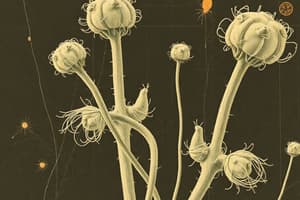Podcast
Questions and Answers
What is gemmulation?
What is gemmulation?
- A method of plant breeding to produce desired traits
- Simple division of plant tissue
- A process involving stem cuttings to yield new plants
- Formation of protective coverings around reproductive structures in the parent's body (correct)
Which of the following is a benefit of asexual reproduction?
Which of the following is a benefit of asexual reproduction?
- High energy costs compared to sexually reproducing species
- Higher vulnerability to environmental stressors
- Increased genetic variation among progeny
- Rapid production of large numbers of offspring promoting evolutionary success (correct)
What is a drawback of asexual reproduction?
What is a drawback of asexual reproduction?
- Increased vulnerability to environmental stressors
- Lower energetic costs compared to sexual reproduction
- Limited evolutionary potential due to less genetic variation among progeny (correct)
- Faster rates of adaptation to ecological conditions
What is a characteristic of asexual reproduction?
What is a characteristic of asexual reproduction?
How does vegetative propagation differ from gemmulation?
How does vegetative propagation differ from gemmulation?
Which type of asexual reproduction involves outgrowths called buds forming on the parent organism's body surface?
Which type of asexual reproduction involves outgrowths called buds forming on the parent organism's body surface?
Why do conservation efforts often rely on both asexual and sexual reproduction strategies?
Why do conservation efforts often rely on both asexual and sexual reproduction strategies?
What is a benefit of asexual reproduction mentioned in the text?
What is a benefit of asexual reproduction mentioned in the text?
What is one field where understanding asexual reproduction has significant application?
What is one field where understanding asexual reproduction has significant application?
Which of the following is an example of an organism that reproduces through fragmentation?
Which of the following is an example of an organism that reproduces through fragmentation?
What is the key difference between budding and fragmentation in asexual reproduction?
What is the key difference between budding and fragmentation in asexual reproduction?
Why is asexual reproduction described as allowing for rapid increase in population size?
Why is asexual reproduction described as allowing for rapid increase in population size?
Flashcards are hidden until you start studying
Study Notes
Reproduction in Animals: Exploring Asexual Pathways
Reproduction is a fundamental process through which life perpetuates itself, ensuring the survival of species across our diverse planet. In this exploration of animal reproduction, we'll focus specifically on a unique phenomenon known as asexual reproduction, delving into its mechanisms, benefits, and limitations.
What Is Asexual Reproduction?
Asexual reproduction does not involve fertilization by gametes from two different parents; instead, it creates genetically identical offspring to their parent(s) using only one individual's genetic material, usually through mitosis rather than meiosis. This mode of reproduction allows for rapid increase in population size without requiring mating partners or extensive energy expenditure.
Types of Asexual Reproduction
-
Budding occurs when small outgrowths called buds form on the body surface of the parent organism, eventually developing into new individuals entirely separate from the original adult. For example, freshwater sponges, some flatworms, and coral polyps reproduce using this strategy.
-
Fragmentation involves breaking apart the parent organism, producing multiple whole individuals that can regenerate lost parts independently. Fragments of plants, such as rhizomes, bulbs, tubers, runners, and stolons, can grow into new clones. Some marine invertebrates like sea stars also reproduce via fragmentation.
-
Gemmulation involves the formation of protective coverings around reproductive structures within the parent's body until they mature enough to become independent. Examples include planaria, brittle stars, bryozoans, and hydra.
-
Vegetative propagation refers to a simple division of plant tissue. For instance, removing stem cuttings or roots yields new plants with nearly identical genetic makeup to the donor plant.
Advantages and Disadvantages of Asexual Reproduction
Benefits:
- Rapid production of large numbers of offspring within relatively short periods increases the chances of successful adaptation under rapidly changing environments, promoting evolutionary success.
- Highly efficient resource utilization due to minimal investment in sexual organs and mating rituals.
- Lower energetic costs compared to sexually reproducing species.
Drawbacks:
- Limited evolutionary potential because there is less opportunity for genetic variation among progeny.
- Increased vulnerability to environmental stressors such as disease, predators, and climate change.
- Slower rates of adaptation, leading to slower response times to shifting ecological conditions.
Applications and Relevance
Understanding asexual reproduction advances scientific knowledge in numerous fields, including agriculture, biotechnology, conservation science, and wildlife management. In plant breeding, asexual methods have been successfully applied to produce desired traits in crops quickly, enabling agriculturalists to meet global demand more efficiently. Conservation efforts often rely upon both asexual and sexual reproduction strategies to preserve endangered species with limited populations. Moreover, studying asexuality sheds light on the extent and role of sexual versus non-sexual processes throughout living systems, providing valuable insights into natural history and evolutionary biology.
Studying That Suits You
Use AI to generate personalized quizzes and flashcards to suit your learning preferences.




